Looking for ways to add WooCommerce Ajax search to your store?
Imagine watching potential customers walk out of a physical store because they couldn’t find what they were searching for, even though the item was right there on the shelf.
This frustrating experience is exactly what happens online when your WooCommerce store’s search function doesn’t deliver. Every slow, irrelevant, or incomplete search result is a missed opportunity, costing you sales.
That’s where Ajax search comes in. Unlike the default WooCommerce search, which requires a page reload and offers limited functionality, Ajax search delivers real-time results as users type. This creates a faster, more intuitive shopping experience that matches today’s customers' expectations and demands.
In this article, we’ll explore the limitations of the default setup, walk you through plugin-based solutions, and focus on the Advanced Woo Search plugin as the easiest and most powerful way to supercharge your store’s search.
Let’s get started.
Why Your WooCommerce Store Needs Ajax Search
The default WooCommerce search is functional, but only just. It was never designed for modern eCommerce expectations, where speed, accuracy, and convenience directly influence whether a visitor becomes a customer.
Limitations of the Default WooCommerce Search
Here’s what you’re working with out of the box:
- No real-time results: Customers must press “Enter” and wait for a new page to load before they see any search results
- Limited search scope: It only looks at product titles and descriptions, ignoring crucial data like SKUs, attributes, custom fields, and variations
- Poor handling of typos: A slight misspelling often leads to zero results, causing frustration and a bounce
- No support for product variations: If a user searches for “blue t-shirt,” they may miss products where “blue” is just a variation
- Lack of relevance ranking: Results aren’t prioritized based on what users are most likely looking for
- No seamless add-to-cart: There’s no way to search and add a product to the cart on the same page without triggering a full page reload
These friction points add up fast, especially on mobile, where every second counts and navigation is already more constrained.
What Customers Expect Today
Online shoppers expect fast, accurate, and seamless search experiences. Even a one-second delay in page load time can reduce conversions, and irrelevant or empty search results often lead to abandoned sessions.
WooCommerce Ajax search addresses this by delivering real-time results as users type, intelligently matching queries to product metadata, and offering a smooth, reload-free interface. This is especially important for mobile users.
Premium solutions even let shoppers add products to their cart directly from the search dropdown, streamlining the path to purchase.
Real-World Impact of Better Search
The benefits of Ajax search go far beyond convenience.
Stores that implement real-time, intelligent search typically see higher conversion rates, as visitors can find what they’re looking for more quickly and are more likely to complete a purchase.
At the same time, bounce rates drop because users stay engaged when the experience feels intuitive and responsive.
Many stores also report an increase in average order value, since a better search experience often surfaces related or complementary products that users might otherwise miss.
If you're serious about improving your WooCommerce store’s user experience and bottom line, Ajax search isn’t just a nice-to-have. It’s essential.
How to Add WooCommerce Ajax Search to Your Store
While it’s technically possible to add Ajax search functionality to your WooCommerce store using custom code, this method is often time-consuming, fragile, and difficult to maintain, especially as your site grows or changes.
It also requires ongoing updates to ensure compatibility with WooCommerce, themes, and other plugins.
For most store owners, using a dedicated plugin like Advanced Woo Search is a far more efficient and reliable solution. It delivers powerful features, easy setup, and long-term flexibility, without writing a single line of code.
The plugin offers one of the easiest ways to add Ajax-powered search to your WooCommerce store. It literally takes only a couple of minutes to set up.
The free version of the plugin helps you add the live search functionality, allowing users to search by product title, content, SKU, and categories. It includes basic customization options and works right out of the box.
The premium version (starting at $69) unlocks advanced features like search by attributes, custom fields, and product variations, multiple result layouts, filtering options, Add to Cart buttons within the Ajax results, AND/OR search logic, and seamless integrations with multilingual and marketplace plugins.
In this tutorial, we’ll learn how to add WooCommerce Ajax search to your store using the free version. Occasionally, we’ll reference the premium version so you can understand the added capabilities it offers.
Step 1: Install & Activate Advanced Woo Search
Start by installing the free Advanced Woo Search plugin from your WordPress dashboard. Go to Plugins → Add New, search for Advanced Woo Search, click Install Now, and then hit Activate.
After activation, you’ll see Adv. Woo Search appears in your WordPress menu. Click on it, go to the General tab, and click the Reindex table button.
This step is essential, and it creates a dedicated search index table that ensures fast and accurate Ajax search functionality across your product catalog. You only need to do this once. After the initial indexing is complete, the plugin will automatically sync new products and changes in the background.
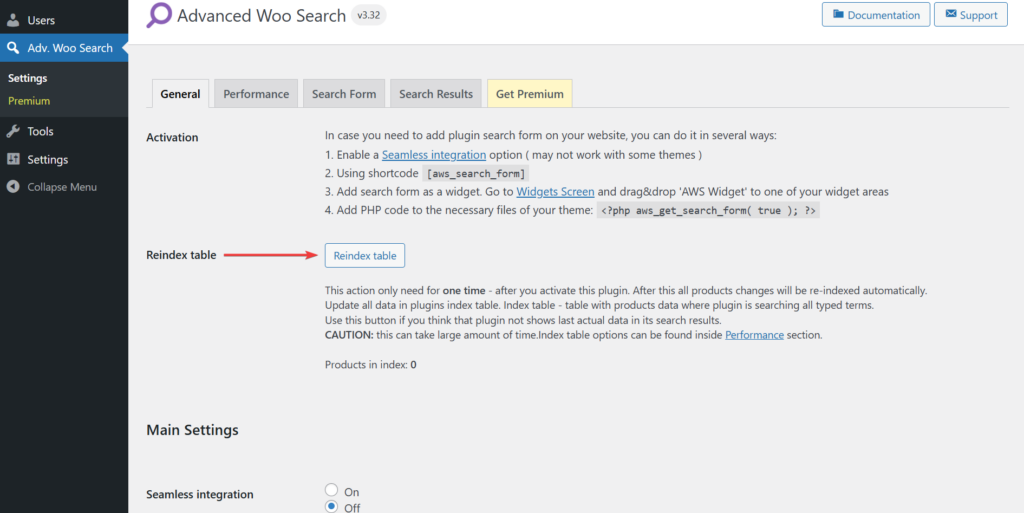
Step 2: Enable WooCommerce Ajax Search
To enable Ajax search, go to Adv. Woo Search → Search Form → AJAX Search and select the On option, and hit the Save Changes button.
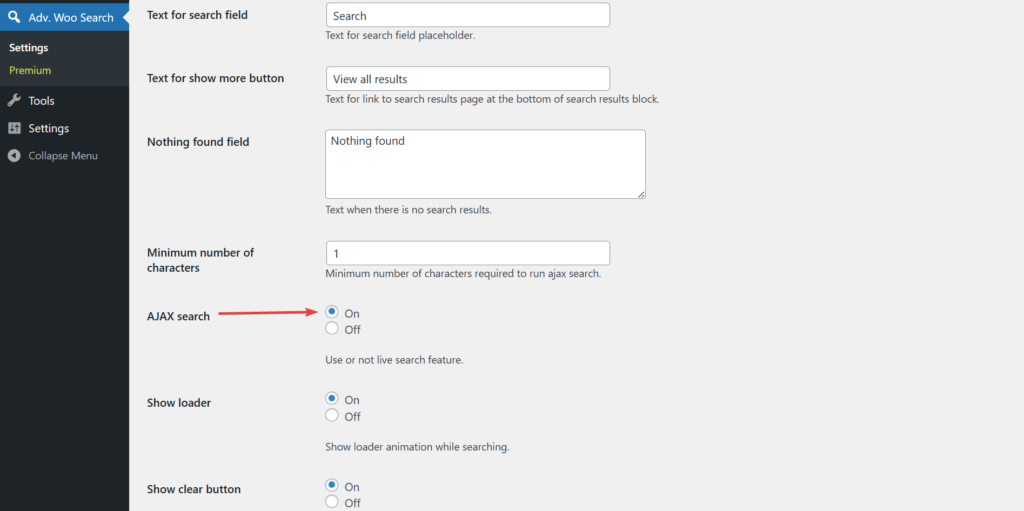
Step 3: Add Search Widget To Store
To add an Ajax-powered search widget to your store, go to Appearance → Widgets, choose a location (such as the WooCommerce Sidebar), add the AWS Widget, and click the Update button.
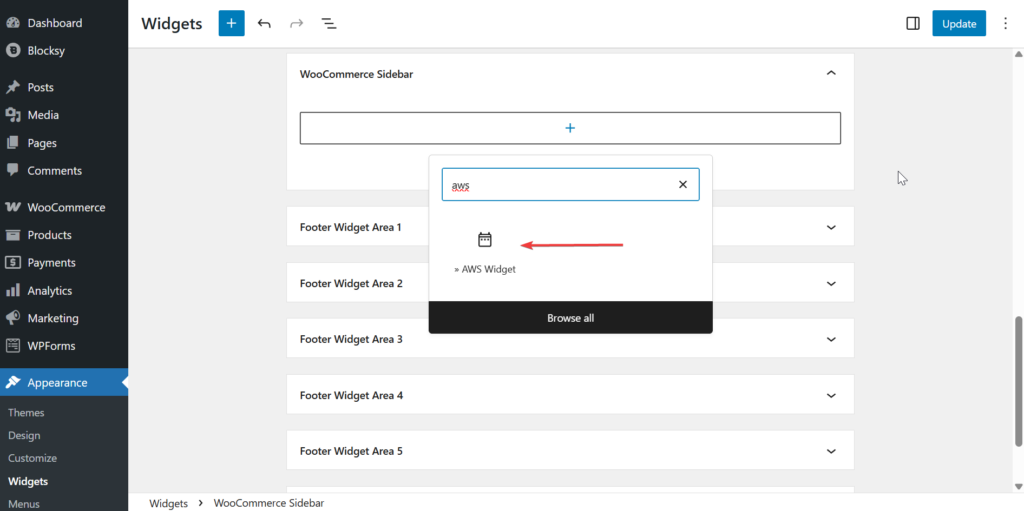
The search widget should now appear on your product archive pages (as shown in the image below).
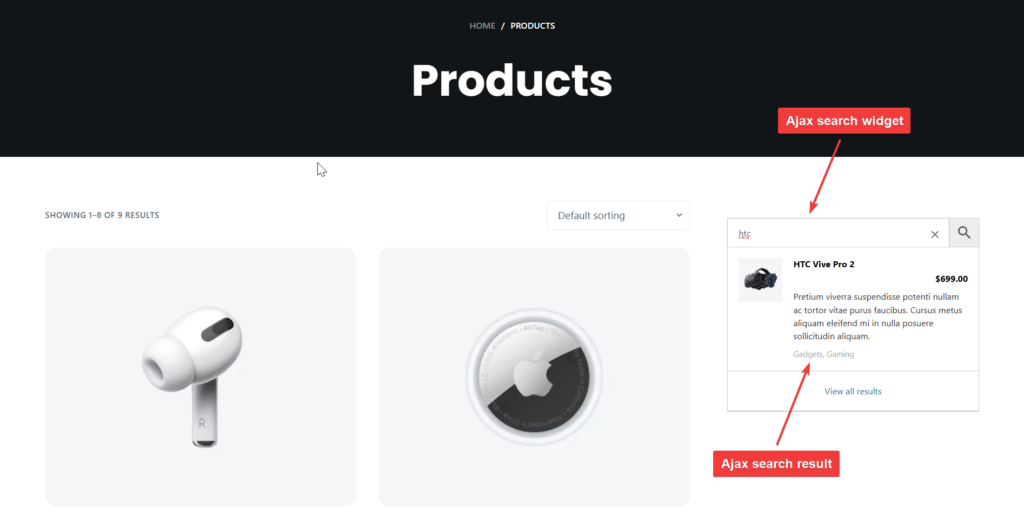
If you don’t see the widget, you might need to clear your cache, or your theme may have sidebar widgets disabled by default. In that case, head to your theme’s Customizer and enable the sidebar for product archive pages.
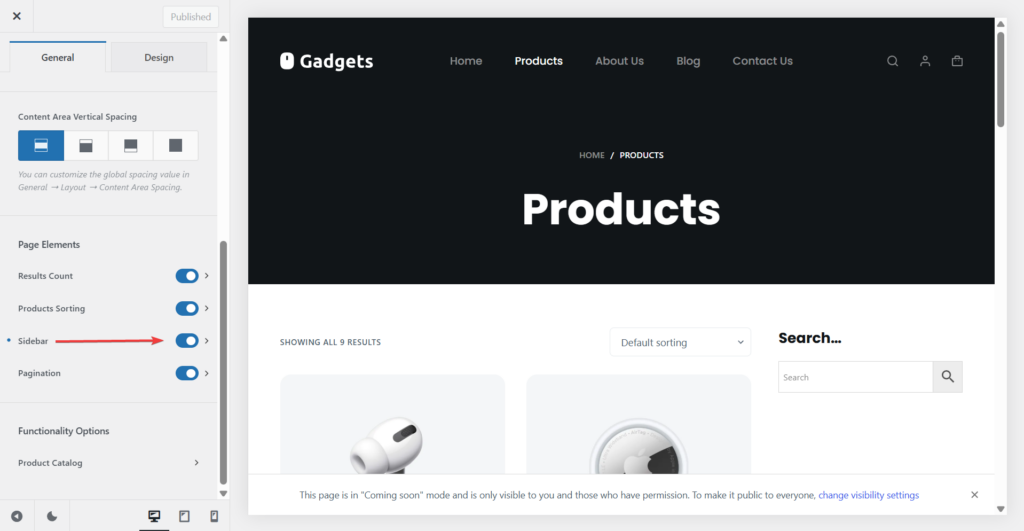
Most themes also let you choose the sidebar position, left or right, so feel free to adjust the placement to suit your design.
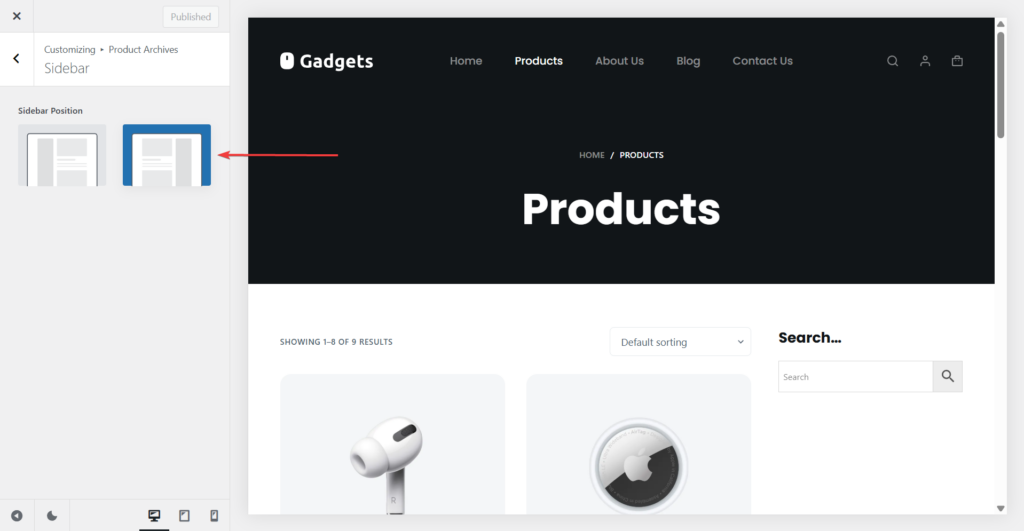
If you’re not using the Gutenberg block editor, you can still display the search widget using a shortcode. Simply copy and paste the shortcode into the WooCommerce sidebar or any widget-ready area on your site.
Free plugin users can use this shortcode:
[aws_search_form]
Pro plugin users may have multiple custom search forms. Make sure to use the correct shortcode from Adv. Woo Search → General.
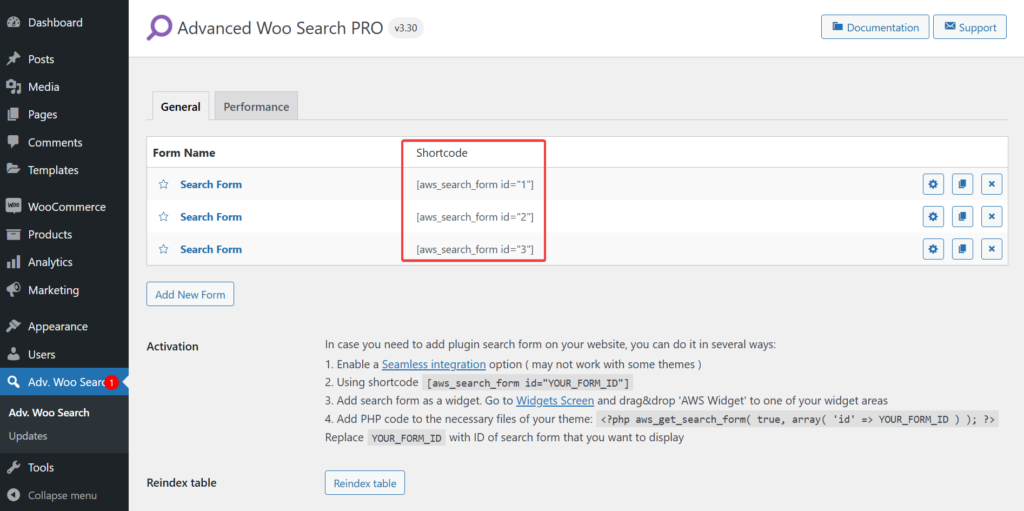
It’s also worth noting that if Pro users use the shortcode without specifying a form ID, the plugin will load the default form, either the one marked with a star in the search forms table or, if none is marked, the first form in the list.
Step 4: Configure AWS Settings
Once the WooCommerce Ajax search is added, it’s time to fine-tune how the Ajax search behaves and looks on your store.
Whether you’re using the free or pro version of Advanced Woo Search, the settings panel is where you’ll customize everything from search sources to front-end appearance.
Free AWS Plugin Settings
If you're using the free version, you'll find a clean, tabbed interface that makes setup straightforward.
The General tab lets you choose which product data should be searchable, like titles, SKUs, or descriptions, and gives you control over keyword exclusions and indexing.
The Performance tab includes options to help optimize speed, especially useful for stores with large catalogs.
The Search Form tab allows basic visual tweaks like input placeholder text and “Nothing Found” messages.
Finally, the Search Results tab controls which details (e.g., images, price, SKU) are shown in the live Ajax dropdown, letting you present search results in a way that matches your store's design and goals.

Pro AWS Plugin Settings
The Pro version builds on this foundation by introducing Search Form Instances, which are individual search forms you can configure separately for different parts of your site. This means you can have one search form optimized for your homepage and another for product category pages.
Each instance can have its own filters, styling, and result display rules.
The Search Results tab in the Pro version also unlocks powerful display logic, allowing you to show or hide elements like badges, stock status, or custom fields based on complex criteria.
With these advanced tools, you can create a personalized, high-converting search experience tailored to different audiences and contexts.
Step 5: Replace All Standard Search Forms (Optional)
If your theme includes a built-in search bar in the header, navigation menu, or other hardcoded areas, replacing it manually using widgets or shortcodes can be tricky. Adding forms in multiple places also increases the chances of inconsistency across your site.
That’s why we recommend enabling Seamless Integration, a feature available in both the free and pro versions of Advanced Woo Search. It’s the quickest and most effective way to automatically upgrade all existing search forms on your site to use the plugin’s Ajax-powered search.
Once enabled, Seamless Integration ensures:
- A fast, consistent WooCommerce Ajax search experience across your entire site
- Automatic replacement of theme and plugin search forms without code changes
- Compatibility with many popular WooCommerce themes and their built-in search bars
To enable this feature, go to Adv. Woo Search → General → Seamless Integration, toggle it on, and hit Save Changes. The plugin will handle the rest, no manual placement required.
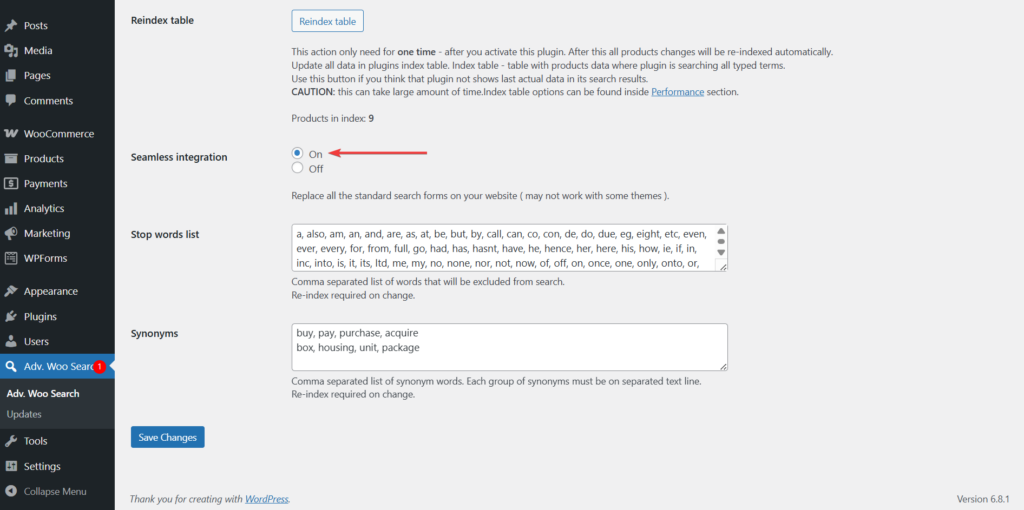
For Pro plugin users with multiple search forms, Seamless Integration will automatically apply the form marked as Main (indicated by a star icon). If no form is marked as the main one, the plugin will default to using the first form in the list.
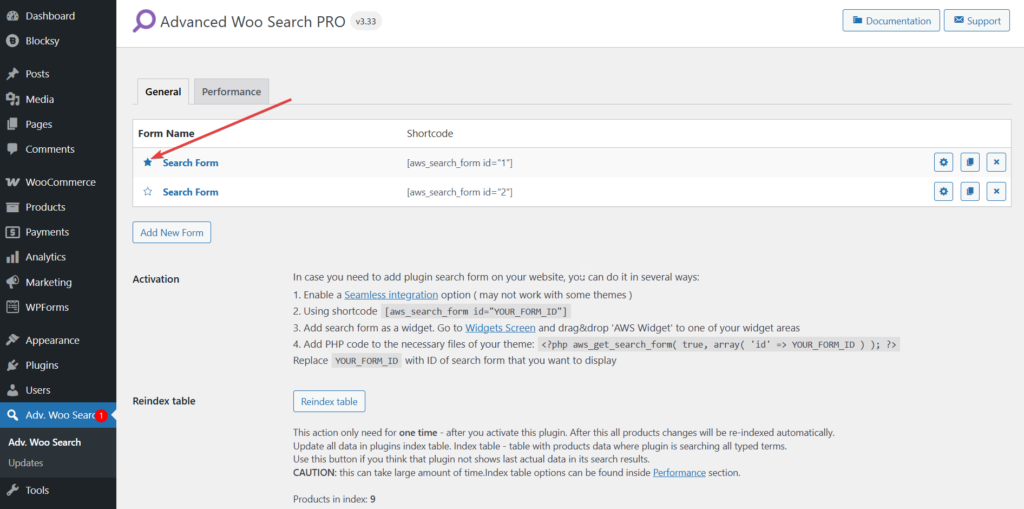
While Seamless Integration works flawlessly with the vast majority of WordPress themes, there are rare cases where it may not replace the default search form or may slightly affect layout styling.
If this happens, consider switching to one of the other integration methods, like widgets or shortcodes.
And if you need assistance, don’t hesitate to contact the support team - we are here to help.
Troubleshooting Common Issues
While WooCommerce Ajax search significantly improves the shopping experience on your store, it's not immune to occasional hiccups, especially during setup or when working with custom themes and plugins. Here’s how to tackle the most common issues store owners encounter:
Search Not Displaying Results
One of the most frequent issues is when the search appears to work but returns no results. This is usually due to incomplete indexing, misconfigured search settings, or restricted product visibility. Start by checking the plugin’s indexing status and ensure that the correct data sources, like product titles, SKUs, attributes, and categories, are selected in the settings. Also, make sure your products are published, visible, and not excluded from search.
Performance Problems With Large Catalogs
If your store has thousands of products, you may notice slower response times during live search. This is often a server performance issue rather than a plugin flaw. You can improve search speed via Advanced Woo Search’s built-in performance settings, which allow you to adjust how the plugin processes search queries and manages its index. Learn more: AWS Performance Options.
Styling Conflicts With Themes
When the search box or results dropdown doesn’t visually match the rest of your site, or appears misaligned, the issue usually lies in CSS conflicts with your theme. Advanced Woo Search offers built-in styling controls, but for more precise adjustments, custom CSS is often the best solution. You can also disable the plugin’s default styles if you prefer to fully manage the appearance through your theme.
Mobile Display Issues
On mobile devices, search interfaces sometimes overlap with other elements or become hard to tap. This is often a placement or layout issue. Advanced Woo Search also offers a mobile-specific layout for search results that is designed to improve usability on touch devices. Learn more: AWS Mobile Support.
Plugin Compatibility Problems
Occasionally, other plugins can interfere with Ajax functionality, especially those that load their own JavaScript or modify product queries. If the search suddenly breaks after installing a new plugin, try deactivating recent additions individually to identify the conflict. You can also check your browser’s developer console for JavaScript errors that might point to the issue.
Most of these problems can be solved quickly with a bit of troubleshooting. And if you’re using the Advanced Woo Search plugin, you’ll have access to detailed documentation and reliable support to help you work through any challenges.
FAQs
1. How do I add a WooCommerce search field to my header?
You can add the search field to your header using a widget, shortcode, or by placing it directly into your theme files. Advanced Woo Search also offers integration options for popular page builders and themes, making header placement quick and flexible without needing custom code.
2. Can I search by product SKU or attributes?
Yes. With Advanced Woo Search, you can configure the plugin to index and search by SKU, custom attributes, tags, categories, and more. This allows customers to find products based on specific details beyond just the title or description, improving the accuracy and relevance of search results.
3. Does WooCommerce Ajax search work with multilingual stores?
Yes, WooCommerce Ajax search works with multilingual plugins like WPML or Polylang. Advanced Woo Search supports these tools, letting users search and view results in their preferred language. Make sure each language's content is properly indexed to ensure accurate, localized search results for international audiences.
4. Can I disable the search results page and use only live Ajax search?
Yes. Advanced Woo Search allows you to rely solely on the live Ajax dropdown for results, bypassing the default search results page entirely. This creates a smoother, faster user experience by keeping customers on the same page while they search, especially effective for quick product discovery.
Conclusion
An effective search experience is no longer optional, and it’s a core part of what makes or breaks a WooCommerce store.
WooCommerce Ajax search helps your customers find what they want faster, boosting satisfaction, reducing bounce rates, and ultimately increasing sales.
From real-time results to improved relevance and seamless add-to-cart functionality, it transforms how users interact with your store.
Whether you choose a plugin like Advanced Woo Search or opt for a custom implementation, upgrading your search should be a top priority.
You now have a clear path forward, with practical steps, optimization tips, and troubleshooting help to guide the way.
Ready to supercharge your store’s search? Try Advanced Woo Search today and give your customers the experience they deserve.
Comments